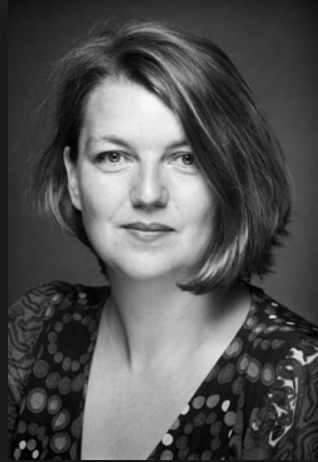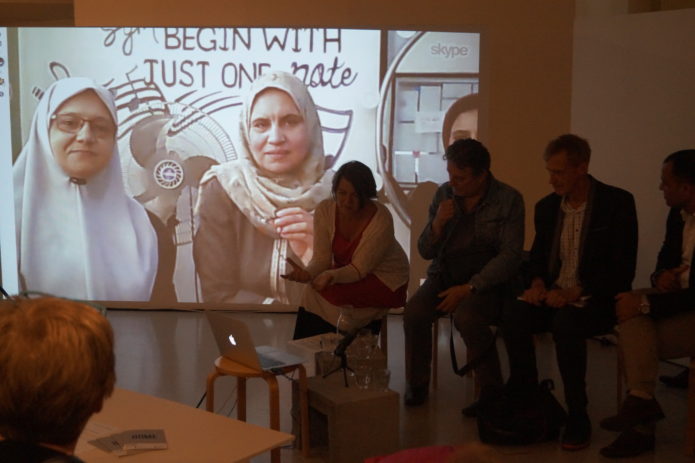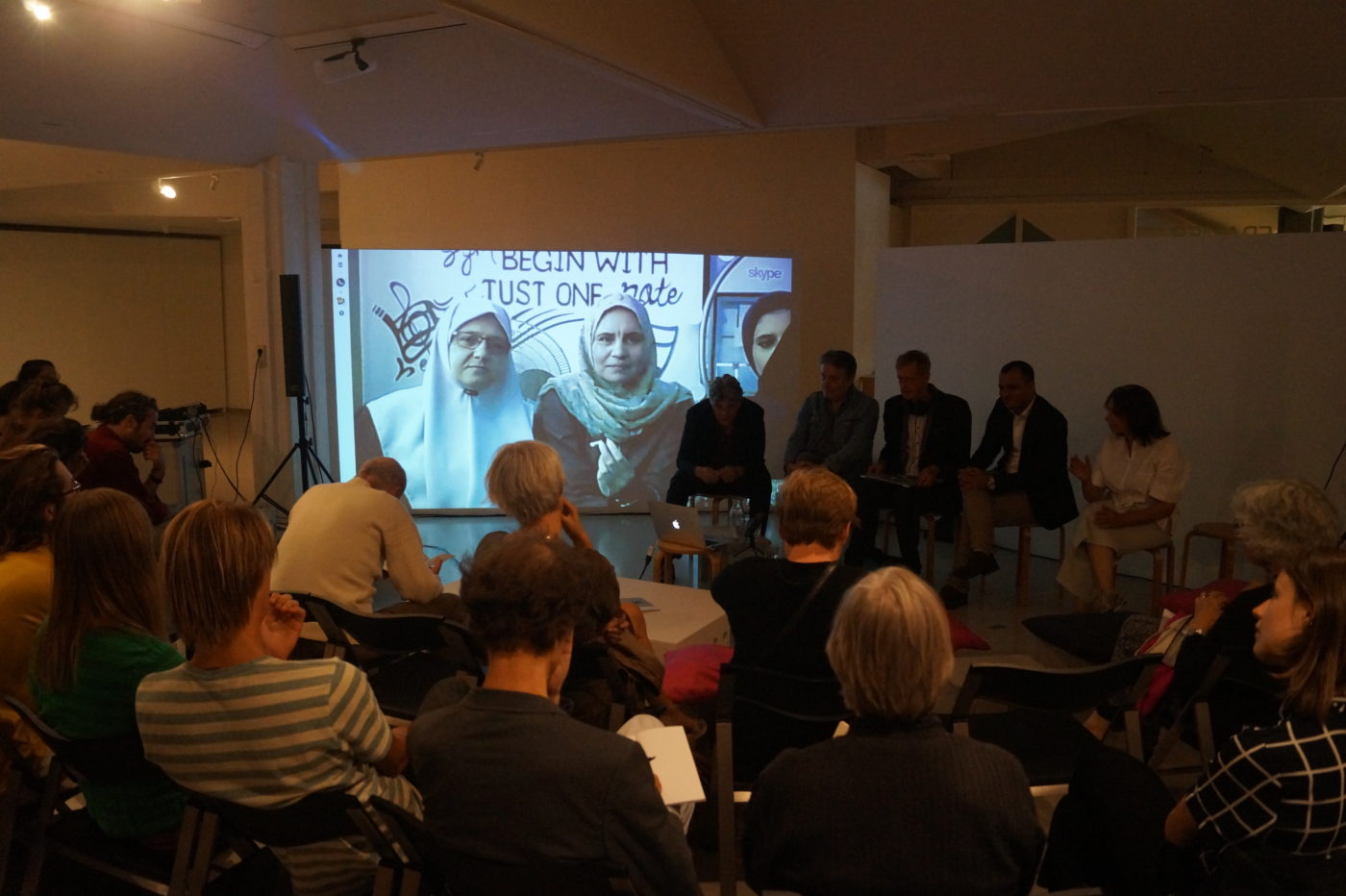 Live conversation HOME #2: The Nakba, Heritage and Cultural Memory
Live conversation HOME #2: The Nakba, Heritage and Cultural Memory Report: Live Conversation HOME #2: The Nakba, Heritage and Cultural Memory in Palestine
On Sunday afternoon August 6th 2017, Framer Framed hosted the second event in the context of exhibition HOME, titled The Nakba, Heritage and Cultural Memory. The event revolved around the experience of not being able to access your own cultural memory and history and thereby the discarded narrative and appropriation of the Palestinian story by the Israeli government from 1948. A Skype connection was established with Gaza Sky Geeks, a start-up hub in Gaza, and the Framer Framed exhibition space in Amsterdam North.
The event revolved around the experience of not being able to access your own cultural memory and history and thereby the discarded narrative and appropriation of the Palestinian story by the Israeli government from 1948. Chris Keulemans moderated the conversation.
The afternoon started of with the screening of the documentary The Great Book Robbery (2011) by Benny Brunner, which explores the appropriation of Palestinian books and manuscripts in 1948 and the implications of this act today. In the documentary film, Brunner and his crew tasked themselves with documenting the looting of the books belonging to the 700.000 Palestinians who fled and were expelled from their homes by the Zionists in 1948, an event that is known as the Nakba. In the years after, librarians from the Jewish National Library and the Hebrew University Library went into the desolated homes of the fled Palestinians in West Jerusalem and took 30.000 books, manuscripts and newspapers. According to the Israeli, they were ‘loaned’ to the National Library where they have remained until now and where the librarians preserved them. In other cities too, such as Jaffa, Haifa, Tiberias and Nazareth, the Israeli government confiscated the cultural assets the Palestinians couldn’t bring with them and were either sold or ‘saved’ in the National Library. The Israeli government and the National Library see the taking of the ‘abandoned property’ as a ‘cultural rescue operation’, where the Palestinians experience it as ‘cultural theft’.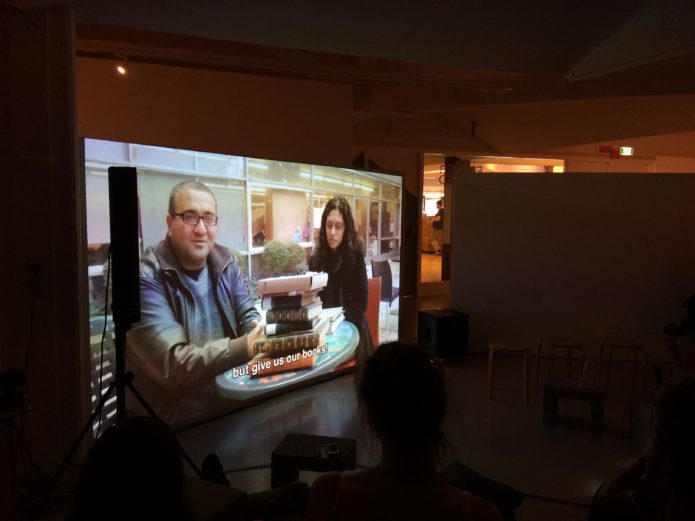
After the film screening we continued with a conversation between the guests at Framer Framed and at Gaza Sky Geeks. The guests in Amsterdam were the above mentioned film maker Benny Brunner, Neil van der Linden and Mohammed Omer. Benny Brunner is an Israeli-Dutch filmmaker who has written, directed and produced films about the history of the Israeli-Palestinian conflict since the 1980s. Neil van der Linden is a Dutch consultant, curator and programmer in music, theatre and visual art from the Middle East, North Africa and Central-Asia who focuses on the representation of Palestine and how the West receives the image of this part of the world. Mohammed Omer is a Palestinian award-winning journalist who has reported for a variety of media, including The New York Times, The Washington Report on Middle Eastern Affairs and Al Jazeera. He obtained a Ph.D. at the Erasmus University, Rotterdam in media communications and is currently a visiting researcher at Harvard University.
From Gaza we spoke to two women who represent the IWAN Centre For Architectural Heritage, an institution that strives for awareness of a Palestinian identity among Palestinians by preserving and conserving traditional buildings. Firstly Nashwa Y. Alramlawi, project coordinator of the centre, who obtained a Ph.D. in Social Housing from the University of Science Malaysia and now works as assistant professor at the Department of Architecture at the Islamic University of Gaza. Secondly, Suheir Mohammed Saleem Ammar, manager of the IWAN Centre, obtained her master’s degree in Architectural Heritage at the Islamic University of Gaza and has since been working in the cultural heritage field. After watching the documentary, it was easy to create a link between the confiscation of the books and the work the IWAN Centre does in conserving the cultural and architectural heritage of Gaza. Suheir Mohammed Saleem Ammar stressed how the Israeli didn’t only steal the Palestinian books, but also destroyed their land. The two different aspects of culture carry the same story with them: the Israelis claimed them. The employees of the IWAN Centre consider it their mission to save and conserve traditional buildings when they are threatened or destroyed, in order to prove it’s theirs and part of their culture, to make the next generations aware of the Palestinian history. Nashwa Y. Alramlawi added that books, land and houses are substances that carry around identity, and people using these substances take their identity from them. She emphasized the mission of the IWAN Centre: to give the Palestinians an idea of their identity and to preserve that identity. This mission statement lead to a question that shaped the rest of the conversation: how to preserve an identity that has been stolen and to which access has been denied?
Chris Keulemans mentioned an example of the movie showing photographs of former, traditional architecture of Palestinian houses that could be helpful for the IWAN Centre, but to which Palestinians do not have access. Mohammed Omer could only agree on this. As a journalist and academic, his work would change in a lot of ways if he would have access to Palestinian history and culture. During his Ph.D., he couldn’t obtain an exit permit to leave the Gaza strip to go to Israel to find the resources he needed. Which, according to Mohammed Omer, lead to a reality in which most of the people living in Gaza do not have a good idea about their own history, because they do not have access to their resources. He stressed how Palestinians phrase the circumstances as a ‘war on memory’ in which the Israeli government erases part of their history and mutilates the identity of the Palestinian people. The whole cultural life of Gaza is controlled by Israel. Israel controls the education system of Palestinian children. There is only one printing house in Gaza, and the moment they press a book that will be taught in schools in Palestine without approval of the Israelis, the Israeli government will shut down the printing house immediately. The representatives from the IWAN Centre respond to this by underlining the importance of the role in society of the IWAN Centre: if not by books, the youngest generation should be made aware of their history and cultural heritage by being included in the rediscovery of the architectural wealth of the Gaza.
IWAN Centre organizes many workshops and events for students to learn about and become aware of their cultural heritage and to make them care about preserving and conserving their houses. Since a great part of Palestinian young artists are being isolated in Gaza from the rest of the world, IWAN Centre also actively works with the artists and gives them as much inspiration as possible by making them aware of their heritage and identity. Neil van der Linden agreed that in order to build a future that includes culture and art, it is necessary to have access to your history. He mentions two Palestinian artists from the West Bank, Basel Abbas and Ruanne Abou-Rahme, who collect historical Palestinian film footage and re-edit them to reflect on the collective memory that the world has about Palestine. Neil van der Linden showed the public a few photographs he found in the Arab Image Foundation that show us an urban society and ordinary social life in Palestine. One of the pictures dates from 1963 and displays an image of a BMW, with three very fashionable ladies posing on top of it in Jericho, West Bank. Another image from 1903 in Nazareth shows us a group of men playing a board game on the streets of the city. According to Neil these images go against the images of the rural society of Palestine that has been dominating the media, but proves that life has been urban and modern there too. He adds to this how the national narrative of Israel tries to be one monolithic image of a mostly white, Jewish (Ashkenazi) state. Even inside Israel, the input of the Sephardic, Eastern and Babylonian Jews has been marginalized for a long time.
In a way, the looting of the books and the confiscation of the land is cultural appropriation. Chris Keulemans mentioned archaeological objects that were dug up in Gaza by Israeli archaeologists and that are now shown in Israeli museums, out of reach for the Palestinians. Mohammed Omer added to this that some Palestinians collaborate with Israeli archaeologists, who collect and dig up the artefacts and then sell them to Israel. To him another striking fact is how the Israeli airline El Al sells Palestinian embroidery in the form of traditional Palestinian dresses, which the airline claims as being authentic Israeli. Neil van der Linden stressed that the theft of identity is perhaps the most important crime. It denies, not only for the Palestinians but also for the rest of the world, the consciousness of the Palestinian history.
Meta Knol, the curator of exhibition ‘HOME’ came forth and asked the women from the IWAN Centre how they look at the future and what their ideas are on how to keep conserving, assuming that the unstable situation of the Gaza Strip must make it hard to make plans for the future. Suheir Mohammed Saleem Ammar and Nashwa Alramlawi strongly believe that IWAN can keep doing what they have been doing and that the future will not be any different from the current day. The centre will continue with their mission, and work with organizations like UNESCO to establish that. They proudly told the public about one of IWAN’s recent projects, for which Nashwa Alramlawi was the supervisor and the architect: the reconstruction of the Khodr monastery in Deir-al-Balah that IWAN turned into a children’s library. The building started as a monastery and after the Islamic conquest the space became a mosque, which creates a unique place, linking the Christian heritage with the Islamic heritage. This is an ultimate example of IWAN’s work: to rebuild a historical place and make new generations aware of its history. Gaza has a known history that goes back in time 4000 years, and we cannot allow letting this history be forgotten. Benny suggested that IWAN should also focus on other aspects of culture and not just architectural history. He puts a remark on how occupation of land is not the end of a story, but also a beginning of story, which can also be the beginning of the mission of IWAN Centre. The stages that follow are the occupation of identity and cultural space, in which you the occupier appropriates physical artefacts like books and archaeological findings. He regards the Israel’s attitude as a typical colonial attitude: the people with ‘knowledge’ bring in this ‘knowledge’ and ‘organizational skills’ to show the natives who do not possess this same type of knowledge.
After two hours we have to end our Skype connection with Gaza Sky Geeks, but we continued for thirty minutes in which Neil van der Linden showed pictures from the Arab Image Foundation and by questions from the audience. The discussion soon reached the question of how one deals with the current political situation, the one state/two state discussion and on whether or not you can talk about colonialism. Thirty minutes cannot capture the depth of subjects like this, but Benny Brunner and Mohammed Omer shortly summarized their opinions on it. Brunner recognized the newer generations of Israel that is locally born, who take initiatives and come together in small groups to find ways to coexist in peace. He gives One Homeland Two People as an example. He hopes that these initiatives will slowly come and grow, which eventually will lead to living together. He stresses how idealistic this is to talk about (especially in such a shortened version), with the realities going on today on the Israeli and Palestinian grounds, but he stresses the importance on how every initiative is a step in the right direction. Omer strongly feels that the Israeli need to stop financing the occupation. He doesn’t want to get into the endless one state/two state discussion, but thinks that by just letting people have the freedom of movement to get in and out of Palestine and make sure everyone has access to their resources, would be a good step in the right direction. He ends the afternoon with stressing how impossible it is to bring books into the Gaza; sending mail from the Gaza to the outside is not possible and vice versa it takes two to three years to get your parcel into the strip. Without a normal way to be able to exit Gaza, and without being able to read books about your own history, he doesn’t see a peaceful future for the Palestinians living in Gaza.
HOME #2: The Nakba, Heritage and Cultural Memory showed the importance of having an idea of your cultural memory and history, and how problematic it is if access to these recourses is denied. The Israeli/Palestinian conflict has many effects on the cultural life of Palestinians for which organizations like the IWAN Centre have to work hard to maintain their heritage and identity, especially for future generations. Solutions like opening up the borders are hard to establish, since the political situation in the region is so complicated that it will most likely not change anytime soon. For now we can create awareness, by preserving architectural heritage like the IWAN Centre does, writing about the situation as Mohammed Omer or making documentary films as Benny Brunner does.
Report written by Astrid Kerchman
Palestine / Middle East / Contested Heritage /
Exhibitions
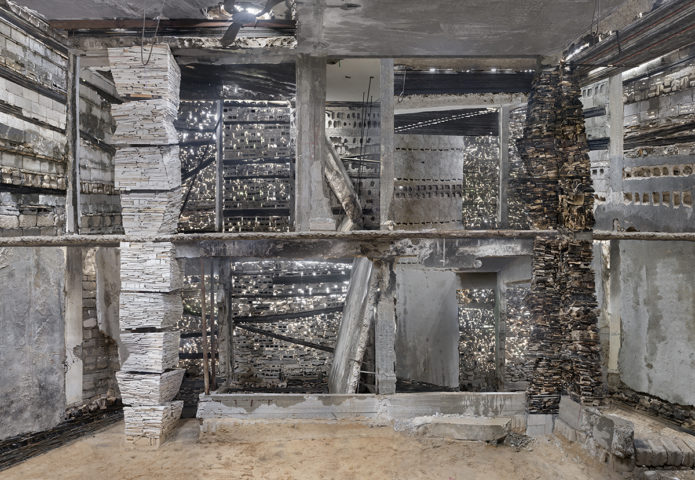
Exhibition: HOME
With work by Marjan Teeuwen, Ezz Al Zanoon and Rawan Mahady, curated by Meta Knol
Network
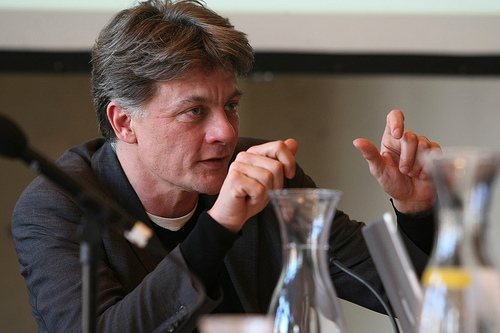
Chris Keulemans
Author
